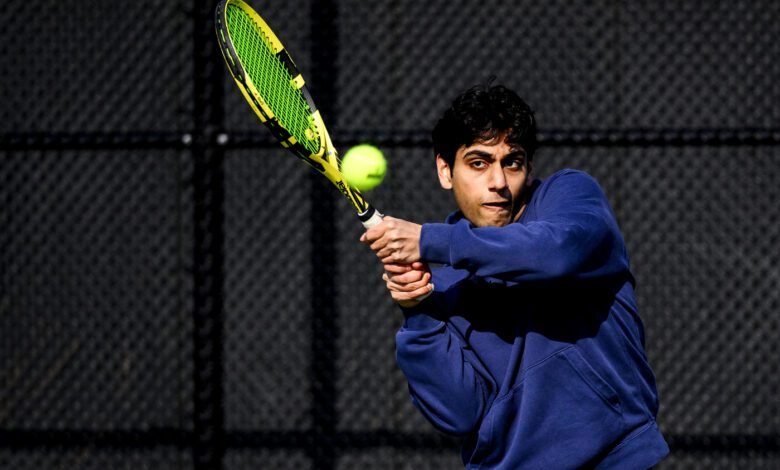Can racquet sports like pickleball and tennis help you live longer?

Research suggests that picking up a racket can be extremely beneficial, but evidence of the long-term health effects of specific sports is lacking.

Racquet sports like pickleball — often referred to as the fastest-growing sport in the United States — are clearly having a moment. New partnerships, leagues and pickleball courts are popping up everywhere.
And what’s more, research suggests that picking up a racket may be among the best decisions a person can make for their health. A study involving nearly 80,000 people showed that racquet sports were correlated with a reduction in all-cause mortality; Another study that compared racquet sports to other forms of exercise found that participants who played tennis and – yes – badminton lived longer than cyclists, football players, runners and swimmers.
But evidence of the long-term effects of specific sports on health is lacking, studies acknowledge. So Northeastern Global News asked Art Kramer, professor of psychology and director of the Center for Brain and Cognitive Health, who studies exercise and its effects on the body and brain, for some perspective on these findings and the broader literature.
His comments have been edited for brevity and clarity.

The Copenhagen City Heart Society found that badminton adds an average of 6.2 years to a person’s life compared to an inactive person, and tennis adds almost a decade at 9.7. It’s a frequently cited study. What do you think?
Firstly, it was an observational study, which means we cannot establish a causal relationship between playing racket sports and a longer life. But if I had to speculate about why they might have seen the benefits they did in racquet sports, one possibility is that not only do they involve good exercise, in that you don’t take many breaks between games – and in tennis and pickleball, sometimes you play for long periods of time – but it’s also very social, right? If there is a link between racquet sports and slightly better levels of mortality and perhaps brain health, that may be because it’s not just exercise, it’s exercise. with others – and social interaction has been found to have benefits for cognitive and brain health.
But there may be a variety of factors involved that we can’t see, which is often the case in these longitudinal studies of people who participate in some of these sports. It may be that they are in better shape to begin with. Perhaps they abstain from certain bad habits, such as drinking or smoking. For starters, people who enjoy this type of sport can be very healthy, and I bet there is some truth to that, because if you are having health problems, it will be very difficult to run around on a court for an hour or two. .
Why do you think pickleball is so popular among seniors? Is it helping them stay healthy?
I think the fact that it’s a much smaller court and you have two people on the court is very appealing. If you’re a really good player and good at positioning the ball, you can place it between two people, but it doesn’t take much movement to retrieve even a well-placed ball compared to the kind of movement required in tennis. court. There is not much space between people playing doubles tennis. I think that’s why older people play pickleball, mainly because it’s easier to move when you can’t move as well as you did when you were younger.
You’ve spent your career studying, among other things, the effects of exercise on brain health. Can you provide a summary of some of the key findings?
For starters, what’s good for your heart is good for your brain, and the exercise you get from playing racket sports undoubtedly helps your heart. This exercise reduces the build-up of plaque in your arteries, which you don’t want; reduces hypertension, which is often the result of high blood pressure; tends to lower A1C, which is a marker of glucose metabolism in type 2 diabetes; and decreases LDL, or bad cholesterol, and increases HDL, good cholesterol. So there’s a wide variety of things that exercise does to the heart, and if your heart is working well and your arteries aren’t clogged with plaque, your brain will function better.
This is one of the reasons our brains work better with exercise, and there are a number of other reasons; and we know a lot of these other reasons because of rodent research, because we can do the histology that humans never volunteer for when they’re alive. We know that exercise increases the birth of new neurons, as well as new connections between neurons; increases blood flow to the brain, similar to the heart; it increases nerve growth factors and a whole variety of other things – it even increases, at a molecular level, mitochondria – the little energy factories that we have inside neurons and cells in general. There are a multitude of changes that occur as a result of exercise – many of them related to blood flow, but not all.
There has been a lot of talk about the precise level of intensity needed to receive the health benefits of exercise. Do you have any ideas about what exercise intensity is best and whether racquet sports like tennis and pickleball meet those ideals?
There have not been many studies that have compared different dosages in the same studies, on the same outcome measures, and in the same population. We’re actually running one right now. We are just beginning to analyze data from 650 older adults – people aged 65 to 85. We have a control condition, which is stretching, but two aerobic conditions; one is 150 minutes per week, the other is 225 minutes per week, that is, a 50% difference. We are looking at many of these factors as a function of dose.
Currently, there simply isn’t enough information to know how much exercise is enough, and this likely differs depending on age and health. What’s enough for you may be too much for me, and children tend to be in constant motion. What is enough for a 10 or 12 year old may not be something you or I can do. In fact, this is probably true for most adults because, quite simply, we all have to work. There are huge individual differences in what a person can do – it depends on the person’s health; depends on previous history; and it depends on genetics, to some extent.





